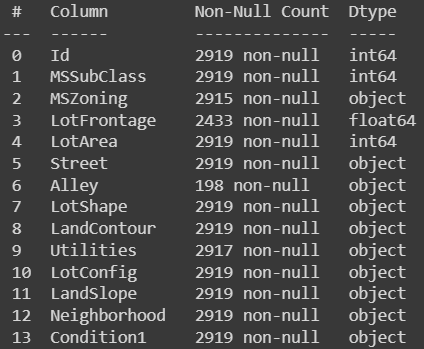| 일 | 월 | 화 | 수 | 목 | 금 | 토 |
|---|---|---|---|---|---|---|
| 1 | 2 | 3 | 4 | 5 | 6 | |
| 7 | 8 | 9 | 10 | 11 | 12 | 13 |
| 14 | 15 | 16 | 17 | 18 | 19 | 20 |
| 21 | 22 | 23 | 24 | 25 | 26 | 27 |
| 28 | 29 | 30 | 31 |
Tags
- Substring with Concatenation of All Words
- 컴퓨터의 구조
- 715. Range Module
- Class
- 파이썬
- iterator
- 밴픽
- LeetCode
- Convert Sorted List to Binary Search Tree
- attribute
- 315. Count of Smaller Numbers After Self
- 30. Substring with Concatenation of All Words
- DWG
- 109. Convert Sorted List to Binary Search Tree
- Python Implementation
- 시바견
- data science
- 43. Multiply Strings
- 프로그래머스
- shiba
- 운영체제
- Python Code
- kaggle
- concurrency
- Protocol
- Decorator
- t1
- Generator
- Python
- Regular Expression
Archives
- Today
- Total
Scribbling
Data Science 101 본문
Data Science 101
1. Data Type and Null Check
all_df.info()
1.1. Nullity
#missing data
total = all_df.isnull().sum().sort_values(ascending=False)
percent = (all_df.isnull().sum()/all_df.isnull().count()).sort_values(ascending=False)
missing_data = pd.concat([total, percent], axis=1, keys=['Total', 'Percent'])
missing_data = missing_data.drop(['SalePrice'], axis=0)
missing_data.head(20)
1.2. Feature Engineering Example
cols = ['PoolQC', 'MiscFeature', 'Alley', 'Fence']
for col in cols:
all_df.loc[~all_df[col].isnull(), col] = 1
all_df.loc[all_df[col].isnull(), col] = 0
all_df['hasExpensiveFeature'] = all_df['PoolQC'] + all_df['MiscFeature'] + all_df['Alley']
all_df["hasExpensiveFeature"] = all_df["hasExpensiveFeature"].astype(int)
all_df['hasExpensiveFeature'].value_counts()
all_df = all_df.drop(['PoolQC', 'MiscFeature', 'Alley'], axis=1)
1.3. Filling in null values
all_df.loc[all_df.Exterior1st.isnull(), 'Exterior1st'] = all_df.Exterior1st.value_counts().index[0]
all_df.loc[all_df.Exterior2nd.isnull(), 'Exterior2nd'] = all_df.Exterior2nd.value_counts().index[0]
2. Feature Types
- Numerical
- Nominal: Categorical without order
- Ordinal: Categorical with order
2.1. Exploring Numerical Features
2.1.1. Correlations
corrmat = train_df.corr()
k = 10 #number of variables for heatmap
cols = corrmat.nlargest(k, 'SalePrice')['SalePrice'].index
cm = np.corrcoef(train_df[cols].values.T)
sns.set(font_scale=1.25)
hm = sns.heatmap(cm, cbar=True, annot=True, square=True, fmt='.2f', annot_kws={'size': 10}, yticklabels=cols.values, xticklabels=cols.values)
plt.show()
2.1.2. Scatter Plot & Removing Abnormal Data Points
var = 'BsmtFinSF1'
data = pd.concat([all_df['SalePrice'], all_df[var]], axis=1)
data.plot.scatter(x=var, y='SalePrice');
all_df = all_df[all_df.BsmtFinSF1 < 5000]
2.1.3. Distribution Plot & Normalizing
- Taking log is useful for skewed feature
f, axs = plt.subplots(1, len(continuous_variables), figsize=(100,5))
for i, cv in enumerate(continuous_variables):
sns.distplot(all_df[cv], ax=axs[i])
plt.show()all_df['SalePrice'] = np.log(all_df['SalePrice'])
2.1.4. Categorizing Target Value for Visualization
analytic_train_df['SalePriceClass'] = 4
first_quartile = analytic_train_df.SalePrice.describe()['25%']
second_quartile = analytic_train_df.SalePrice.describe()['50%']
third_quartile = analytic_train_df.SalePrice.describe()['75%']
analytic_train_df.loc[analytic_train_df['SalePrice'] < first_quartile, 'SalePriceClass'] = 1
analytic_train_df.loc[(analytic_train_df['SalePrice'] >= first_quartile) &
(analytic_train_df['SalePrice'] < second_quartile), 'SalePriceClass'] = 2
analytic_train_df.loc[(analytic_train_df['SalePrice'] >= second_quartile) &
(analytic_train_df['SalePrice'] < third_quartile), 'SalePriceClass'] = 3
analytic_train_dff, ax = plt.subplots(1, 2, figsize=(25, 5))
sns.distplot(analytic_train_df.GrLivArea, ax=ax[0])
sns.histplot(data=analytic_train_df, x='GrLivArea', hue='SalePriceClass', ax=ax[1], element='step')
for i in range(2):
ax[i].spines['top'].set_visible(False)
ax[i].spines['right'].set_visible(False)
ax[i].set_xlabel('GrLivArea', weight='bold', size=15)
ax[i].set_ylabel('Density', weight='bold', size=15)
ax[i].set_facecolor('#f6f5f5')
f.suptitle("GrLivArea' distribution", weight='bold', size=20)
plt.show()
def continuous_dist(data, x, y):
f, ax = plt.subplots(1, 3, figsize=(35, 10))
sns.violinplot(x=data[x], y=data[y], ax=ax[0], edgecolor='black', linewidth=5)
sns.boxplot(x=data[x], y=data[y], ax=ax[1])
sns.stripplot(x=data[x], y=data[y], ax=ax[2])
for i in range(3):
ax[i].spines['top'].set_visible(False)
ax[i].spines['right'].set_visible(False)
ax[i].set_xlabel(x, weight='bold', size=20)
ax[i].set_ylabel(y, weight='bold', size=20)
ax[i].set_facecolor('#f6f5f5')
f.suptitle(f"{y}'s distribution by {x}", weight='bold', size=25)
plt.show()continuous_dist(analytic_train_df, x='SalePriceClass', y='GrLivArea')
2.2.1. Handling Nominal Features & Label Encoding
for nv in nominal_variables:
le = LabelEncoder()
le = le.fit(all_df[nv])
all_df[nv] = le.transform(all_df[nv])
all_df[nv] = all_df[nv].astype('category')If you need to deal with null values:
for cat in categories:
le = LabelEncoder()
all_df[cat].fillna("missing", inplace=True)
le = le.fit(all_df[cat])
all_df[cat] = le.transform(all_df[cat])
all_df[cat] = all_df[cat].astype('category')
2.2.2. One-hot Encoding
train_df_corr = pd.get_dummies(train_df, columns=['Sex'], drop_first=True)
train_df_corr = pd.get_dummies(train_df_corr, columns=['Embarked'])
2.3.1. Handling Ordinal Features & Scatter Plot
all_df = all_df.replace({
"HeatingQC" : {"Po" : 1, "Fa" : 2, "TA" : 3, "Gd" : 4, "Ex" : 5},
"LotShape" : {"IR3" : 1, "IR2" : 2, "IR1" : 3, "Reg" : 4},
"GarageFinish" : {'NA' : 0, 'Unf' : 1, 'RFn' : 2, 'Fin' : 3},
"BsmtExposure" : {"NA" : 0, "No" : 1, "Mn" : 2, "Av": 3, "Gd" : 4},
"BsmtQual" : {"NA": 0, "Po" : 1, "Fa" : 2, "TA": 3, "Gd" : 4, "Ex" : 5},
"ExterQual" : {"Po" : 1, "Fa" : 2, "TA": 3, "Gd": 4, "Ex" : 5},
"BsmtFinType2" : {"NA" : 0, "Unf" : 1, "LwQ": 2, "Rec" : 3, "BLQ" : 4,
"ALQ" : 5, "GLQ" : 6},
"BsmtCond" : {"NA" : 0, "Po" : 1, "Fa" : 2, "TA" : 3, "Gd" : 4, "Ex" : 5},
"GarageQual" : {"NA" : 0, "Po" : 1, "Fa" : 2, "TA" : 3, "Gd" : 4, "Ex" : 5},
"FireplaceQu" : {"NA" : 0, "Po" : 1, "Fa" : 2, "TA" : 3, "Gd" : 4, "Ex" : 5},
"Functional" : {"Sal" : 1, "Sev" : 2, "Maj2" : 3, "Maj1" : 4, "Mod": 5,
"Min2" : 6, "Min1" : 7, "Typ" : 8},
"LandSlope" : {"Sev" : 1, "Mod" : 2, "Gtl" : 3},
"ExterCond" : {"Po" : 1, "Fa" : 2, "TA": 3, "Gd": 4, "Ex" : 5},
"KitchenQual" : {"Po" : 1, "Fa" : 2, "TA" : 3, "Gd" : 4, "Ex" : 5},
"GarageCond" : {"NA" : 0, "Po" : 1, "Fa" : 2, "TA" : 3, "Gd" : 4, "Ex" : 5},
"PavedDrive" : {"N" : 0, "P" : 1, "Y" : 2},
"BsmtFinType1" : {"NA" : 0, "Unf" : 1, "LwQ": 2, "Rec" : 3, "BLQ" : 4,
"ALQ" : 5, "GLQ" : 6},
})f, axs = plt.subplots(1, len(ordinal_variables), figsize=(100,5))
for i, ov in enumerate(ordinal_variables):
sns.scatterplot(data=all_df, x=ov, y='SalePrice', ax=axs[i])
plt.show()
2.3.2. Visualizing Ordinal Features
def cat_dist(data, var, hue, msg_show=True):
total_cnt = data[var].count()
f, ax = plt.subplots(1, 2, figsize=(25, 8))
hues = [None, hue]
titles = [f"{var}'s distribution", f"{var}'s distribution by {hue}"]
for i in range(2):
sns.countplot(data[var], edgecolor='black', hue=hues[i], linewidth=4, ax=ax[i], data=data)
ax[i].set_xlabel(var, weight='bold', size=13)
ax[i].set_ylabel('Count', weight='bold', size=13)
ax[i].set_facecolor('#f6f5f5')
ax[i].spines['top'].set_visible(False)
ax[i].spines['right'].set_visible(False)
ax[i].set_title(titles[i], size=15, weight='bold')
for patch in ax[i].patches:
x, height, width = patch.get_x(), patch.get_height(), patch.get_width()
if msg_show:
ax[i].text(x + width / 2, height + 3, f'{height} \n({height / total_cnt * 100:2.2f}%)', va='center', ha='center', size=12, bbox={'facecolor': 'white', 'boxstyle': 'round'})
plt.show()cat_dist(analytic_train_df, var='OverallQual', hue='SalePriceClass')
3. Prototyping
3.1. Linear Regression
from sklearn.linear_model import LinearRegression
from sklearn.metrics import mean_squared_error
LR = LinearRegression()
LR.fit(train_X, train_Y)
mean_squared_error(LR.predict(train_X), train_Y, squared=False)
3.2. LightGBM
import lightgbm as lgbclass LGBM:
def __init__(self):
self.lgbm_params = {
'objective': 'regression',
'random_seed': 9999,
}
self.best_loss = None
def set_data(self, train_X, train_Y):
self.train_X = train_X
self.train_Y = train_Y
def test(self):
models = []
rmses = []
oof = np.zeros(len(self.train_X))
for train_index, val_index in KFold(n_splits=3).split(self.train_X):
X_train = self.train_X.iloc[train_index]
X_valid = self.train_X.iloc[val_index]
y_train = self.train_Y.iloc[train_index]
y_valid = self.train_Y.iloc[val_index]
lgb_train = lgb.Dataset(X_train, y_train)
lgb_eval = lgb.Dataset(X_valid, y_valid, reference=lgb_train)
model_lgb = lgb.train(self.lgbm_params,
lgb_train,
valid_sets=lgb_eval,
num_boost_round=100,
early_stopping_rounds=20,
verbose_eval=50,
)
y_pred = model_lgb.predict(X_valid, num_iteration=model_lgb.best_iteration)
tmp_rmse = np.sqrt(mean_squared_error(y_valid, y_pred))
models.append(model_lgb)
rmses.append(tmp_rmse)
oof[val_index] = y_pred
self.current_loss = sum(rmses)/len(rmses)
print('Current loss: ' + str(self.current_loss) + '(Previous best loss: ' + str(self.best_loss) + ')')
if self.best_loss == None or self.current_loss < self.best_loss:
self.best_loss = self.current_loss
if self.best_loss == self.current_loss:
self.best_models = models
actual_pred_df = pd.DataFrame({
'actual': self.train_Y,
'pred': oof
})
actual_pred_df.plot(figsize=(12, 5))
lgb.plot_importance(models[0], importance_type="gain", max_num_features=15)lgbm = LGBM()
lgbm.set_data(train_X, train_Y)
lgbm.test()
4. Hyper-Parameters Optimization
import optunaX_train, X_valid, y_train, y_valid = train_test_split(train_X, train_Y, test_size=0.2, shuffle=False, stratify=None)def objective(trial):
params = {
'objective': 'regression',
'metric': 'rmse',
'boosting': 'gbdt',
'random_seed': 42,
'num_boost_round': 2500,
'max_depth': trial.suggest_int('max_depth', 5, 50),
'n_estimators': trial.suggest_int('n_estimators', 5, 50),
'num_leaves': trial.suggest_int('num_leaves', 20, 100),
'learning_rate': trial.suggest_float('learning_rate', 0.01, 0.1, log=True),
'subsample': trial.suggest_float('subsample', 0.7, 1.0),
'colsample_bytree': trial.suggest_float('colsample_bytree', 0.7, 1.0),
'lambda_l1': trial.suggest_float('lambda_l1', 1e-2, 1e-1, log=True),
'lambda_l2': trial.suggest_float('lambda_l2', 1e-2, 1e-1, log=True),
}
lgb_train = lgb.Dataset(X_train, y_train)
lgb_eval = lgb.Dataset(X_valid, y_valid, reference=lgb_train)
model_lgb = lgb.train(params,
lgb_train,
valid_sets=lgb_eval,
early_stopping_rounds=50,
verbose_eval=100)
y_pred = model_lgb.predict(X_valid, num_iteration=model_lgb.best_iteration)
real_y_pred = target_sc.inverse_transform(y_pred[:, np.newaxis])
real_y_valid = target_sc.inverse_transform(y_valid[:, np.newaxis])
score = np.sqrt(mean_squared_error(real_y_valid, real_y_pred))
return scorestudy = optuna.create_study(sampler=optuna.samplers.RandomSampler(seed=0))
study.optimize(objective, n_trials=100)
study.best_paramslgbm_params = {
'objective': 'regression',
'metric': 'rmse',
'boosting': 'gbdt',
'random_seed': 42,
'num_boost_round': 2500,
'max_depth': 26,
'n_estimators': 10,
'num_leaves': 61,
'learning_rate': 0.08903710966970699,
'subsample': 0.8987580600850132,
'colsample_bytree': 0.704071490683633,
'lambda_l1': 0.041961025695416855,
'lambda_l2': 0.047169321672552555,
}lgb_train = lgb.Dataset(X_train, y_train)
lgb_eval = lgb.Dataset(X_valid, y_valid, reference=lgb_train)
model_lgb = lgb.train(lgbm_params,
lgb_train,
valid_sets=lgb_eval,
early_stopping_rounds=50,
verbose_eval=100)
y_pred = model_lgb.predict(X_valid, num_iteration=model_lgb.best_iteration)
real_y_pred = target_sc.inverse_transform(y_pred[:, np.newaxis])
real_y_valid = target_sc.inverse_transform(y_valid[:, np.newaxis])
score = np.sqrt(mean_squared_error(real_y_valid, real_y_pred))
print(score)y_pred = model_lgb.predict(X_valid, num_iteration=model_lgb.best_iteration)
real_y_pred = target_sc.inverse_transform(y_pred[:, np.newaxis])
real_y_valid = target_sc.inverse_transform(y_valid[:, np.newaxis])
actual_pred_df = pd.DataFrame({
'actual': np.squeeze(np.exp(real_y_valid)),
'pred': np.squeeze(np.exp(real_y_pred)),
})
actual_pred_df.plot(figsize=(30, 10))'Computer Science > Data Science' 카테고리의 다른 글
| Pandas Operations Repository (0) | 2022.11.20 |
|---|---|
| (py)Spark Basics (0) | 2022.10.06 |
| Google Cloud Platform Certificate; Professional Machine Learning Engineer (0) | 2022.04.12 |
| 데이터 분석 방법의 기초 - Kaggle 타이타닉 예제 (0) | 2021.11.23 |
| 데이터 분석 방법의 기초 - Kaggle 주택 가격 예측 예제 (0) | 2021.11.23 |


